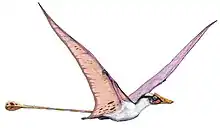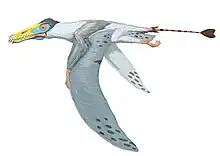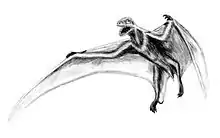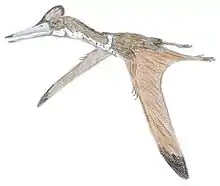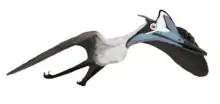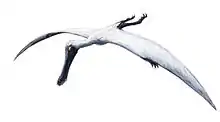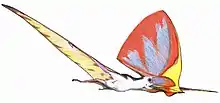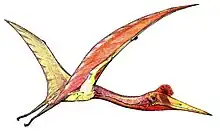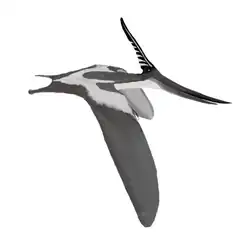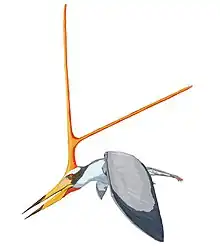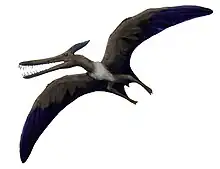Sinopterus
Sinopterus (meaning "Chinese wing") is a genus of tapejarid pterodactyloid pterosaur from the Aptian-age Lower Cretaceous Jiufotang Formation of Chaoyang, Liaoning, China. It was first described and named by Wang Xiaolin and Zhou Zhonghe. Historically, there were multiple species attributed to the genus although only one is considered to be valid. Sinopterus is known for its proportionally large skull, which has a birdlike pointed beak, a long bony crest that starts with a tall premaxilla and goes back along the middle of the skull to form a point overhanging the rear of the skull, and its lack of teeth.
| Sinopterus Temporal range: Early Cretaceous, | |
|---|---|
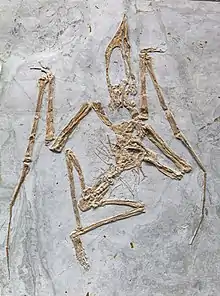 | |
| Fossil specimen of S. dongi, National Museum of Natural Science | |
| Scientific classification | |
| Domain: | Eukaryota |
| Kingdom: | Animalia |
| Phylum: | Chordata |
| Order: | †Pterosauria |
| Suborder: | †Pterodactyloidea |
| Family: | †Tapejaridae |
| Subfamily: | †Sinopterinae |
| Genus: | †Sinopterus Wang & Zhou, 2003 |
| Type species | |
| †Sinopterus dongi Wang & Zhou, 2003 | |
| Synonyms | |
| |
Description
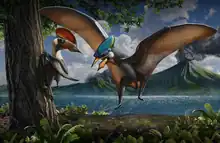
The type species, S. dongi, is based on IVPP V13363, an articulated, nearly complete skeleton. The skull of this individual was 17 centimeters (6.7 inches) long, and the wingspan was estimated to be 1.2 meters (3.9 feet). The authors suggested that it was an omnivore, and noted that it was the first record of a tapejarid outside of Brazil, and the earliest and most complete tapejarid.[1] The maximum adult wingspan of this pterosaur would have been 1.9 metres (6.2 ft), and an individual of this size would have weighed 2.87 kg (6.3 lb).[2]
Classification

Sinopterus is known from numerous specimens, some of which have been assigned to unique species and even different genera over the years. The type species, Sinopterus dongi, is known from one specimen described in 2003. A second specimen, BPV-077, was also described in 2003 by Li, Lü, and Zhang, who classified it in its own species, S. gui. It was said to differ from S. dongi mainly in its smaller size (only about half the size of S. dongi) and the presence of a notarium,[3] though this was later disproved.[4] Some later studies found S. gui to simply represent a younger specimen of S. dongi,[5] though one large analysis in 2014 found it to be a more primitive tapejarid.[6]
A third specimen was referred to Sinopterus in 2007, again classified as a new species, this time given the name S. jii. This species was first named by Lü & Yuan in 2005 as the type species of a new genus which they named Huaxiapterus. Two later studies in 2007 and 2011 both showed that H. jii was in fact more closely related to Sinopterus than to the two other species also assigned to Huaxiapterus, "H." corollatus and "H." benxiensis. Both groups of researchers concluded that Huaxiapterus jii should therefore be reclassified as Sinopterus jii, and that the other two species of "Huaxiapterus" require a new genus name.[4][5] However, a more complete phylogenetic analysis suggested that Sinopterus may actually be an intermediate step in the grade between H. jii and the other two Huaxiapterus species, making Sinopterus paraphyletic if H. jii is included.[6]
In 2016, another species, S. lingyuanensis, was named. It purportedly differed from the other species in the proportions of its nasoantorbital fenestra, its rostral index, the relative sizes of its femur and tibia, and the relative sizes of the first and second wing digits. In the same paper describing this species, the species Huaxiapterus atavismus was also named.[7] However, Xinjun Zhang and colleagues in 2019 considered Huaxiapterus an invalid genus and therefore reassigned H. atavismus to Sinopterus, which created the new combination Sinopterus atavismus.[8]
A 2021 study by Darren Naish and colleagues of variation within pterosaur growth stages noted that numerous species had been classified as Sinopterus or "Huaxiapterus", most based only on a single specimen, and most differentiated from each other by features like wing proportions, skull length, and crest shape and size. Naish et al. pointed out that all of these features are known to be variable within a single species due to growth, and that there were unlikely to be such a high diversity of extremely similar species in the same ecosystem when their differences are more likely due to variation within a few species. They suggested that a larger study would be needed to untangle the question of how many species of Sinopterus-like pterosaurs actually existed in the Jiufotang ecosystem, and how they are related to each other. In a preliminary opinion, these scientists stated that there is likely only one valid species of Sinopterus, S. dongi, but that "Huaxiapterus" corollatus might be a valid second species based on unique wing and leg proportions.[2] Their opinions are confirmed by a ressessment of Chinese tapejarids by Pêgas et al. in 2023, who also name the new genus Huaxiadraco for "Huaxiapterus" corollatus.[9]
In 2023, Rodrigo V. Pêgas et al. reviewed the recent taxonomic histories of the tapejarids. In their article, they made S. gui and S. lingyuanensis synonymous with S. dongi. In addition, the genus Huaxiapterus was synonymized with Sinopterus as a result of H. jii and H. atavismus being reclassified as synonyms of S. dongi and "H." corollatus being reclassified to the new genus Huaxiadraco from which Huaxiapterus benxiensis became synonymous with.[9]
Relationships

The cladogram below follows the 2014 analysis by Brian Andres and colleagues, showing the placement of two Sinopterus species ("S." gui and S. dongi) within the clade Tapejaromorpha.[6]
| Tapejaromorpha |
| ||||||||||||||||||||||||||||||||||||||||||||||||||||||||||||||||||||||||

In 2019, a different analysis, this time by Alexander Kellner and colleagues, had recovered Sinopterus within the Tapejarinae, a subfamily within the larger group Tapejaridae, sister taxon to both Eopteranodon and Huaxiapterus.[10] The cladogram of their analysis is shown below:
| Tapejaromorpha |
| ||||||||||||||||||||||||||||||||||||||||||||||||||||||||||||
Paleobiology
Growth
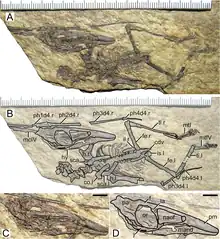
Sinopterus is known from several specimens at various stages of growth, which has allowed scientists to study the changes these animals went through during their life histories.
At least one very small juvenile (possibly hatchling) specimen has been attributed to Sinopterus. This specimen was originally classified as a distinct genus in 2008, Nemicolopterus crypticus. The name Nemicolopterus comes from the Greek words "Nemos" meaning "forest", "ikolos" meaning "dweller", and the Latinised "pteron" meaning "wing". The specific name crypticus is derived from the Greek "kryptos", meaning "hidden". Thus "Nemicolopterus crypticus" means "Hidden flying forest dweller". The type specimen of N. crypticus, catalog number IVPP V-14377, is housed in the collection of the Institute of Vertebrate Paleontology and Paleoanthropology in Beijing, China. The fossil was collected from the Jiufotang Formation, like all adult Sinopterus specimens. It was discovered in the Luzhhouou locality of Yaolugou Town, Jianchang County, Huludao City, western Liaoning Province in northeastern China. It has a wingspan of slightly under 25 centimeters (10 in), making it smaller than all but a few specimens of hatchling pterosaurs.[11] Wang et al. (2008), who originally described the specimen, concluded that it was immature, citing the amount of bone fusion and the ossification of the toes, gastralia, and sternum as indicating that it was a sub-adult rather than a hatchling. However, Darren Naish argued on his popular weblog that, due to the hypothesis that pterosaurs were highly precocial, bone fusion and ossification could have occurred very early in life, and that Nemicolopterus might in fact be a hatchling Sinopterus.[12] This identification was formally presented in 2021 study, which found that Nemicolopterus fit into a growth series as a young juvenile or hatchling Sinopterus hatchling.[2] An analysis of pterosaur relationships by Andres and colleagues in 2014 found the specimen in a sister group relationship with "Sinopterus" gui.[6]
Based on study of hatchling Sinopterus skeletons as well as comparison with hatchlings of other pterosaur species, Naish and colleagues (2021) found that the wing proportions and bone strength/flexibility of hatchlings were similar to adults, and concluded that Sinopterus was capable of powered flight very shortly after hatching. They found that while young juveniles would have been excellent gliders, they would not have been reliant on gliding alone as opposed to true flight. Juveniles also seem to have been more adapted to flight in closed environments, like dense forests, compared to adults. Juveniles therefore probably occupied different ecological niches than adults, transitioning between different niches as they grew.[2]
References
- Wang, Xiaolin; Zhou, Zhonghe (June 2003). "A new pterosaur (Pterodactyloidea, Tapejaridae) from the Early Cretaceous Jiufotang Formation of western Liaoning, China and its implications for biostratigraphy". Chinese Science Bulletin. 48 (1): 16–23. Bibcode:2003ChSBu..48...16W. doi:10.1007/bf03183326. S2CID 43993745.
- Naish, Darren; Witton, Mark P.; Martin-Silverstone, Elizabeth (22 July 2021). "Powered flight in hatchling pterosaurs: evidence from wing form and bone strength". Scientific Reports. 11 (1): 13130. Bibcode:2021NatSR..1113130N. doi:10.1038/s41598-021-92499-z. PMC 8298463. PMID 34294737.
- Li, J.; Lü, J.; Zhang, B. (2003). "A new Lower Cretaceous sinopterid pterosaur from the Western Liaoning, China". Acta Palaeontologica Sinica. 42 (3): 442–447.
- Kellner, A.W.A.; Campos, D.A. (2007). "Short note on the ingroup relationships of the Tapejaridae (Pterosauria, Pterodactyloidea)". Boletim do Museu Nacional. 75: 1–14.
- Pinheiro, Felipe L.; Fortier, Daniel C.; Schultz, Cesar L.; De Andrade, José Artur F.G.; Bantim, Renan A.M. (September 2011). "New information on the pterosaur Tupandactylus imperator, with comments on the relationships of Tapejaridae". Acta Palaeontologica Polonica. 56 (3): 567–580. doi:10.4202/app.2010.0057.
- Andres, Brian; Clark, James; Xu, Xing (5 May 2014). "The Earliest Pterodactyloid and the Origin of the Group". Current Biology. 24 (9): 1011–1016. doi:10.1016/j.cub.2014.03.030. PMID 24768054. S2CID 18293296.
- Lü, Junchang; Teng, Fangfang; Sun, Deyu; Shen, Caizhi; Li, Guoqing; Gao, Xia; Liu, Hanfeng (2016). "The toothless pterosaurs from China". Acta Geologica Sinica. 90 (9): 2513–2525. Archived from the original on 2016-10-11. Retrieved 2016-10-10.
- Zhang, Xinjun; Jiang, Shunxing; Cheng, Xin; Wang, Xiaolin (27 June 2019). "New Material of Sinopterus (Pterosauria, Tapejaridae) from the Early Cretaceous Jehol Biota of China". Anais da Academia Brasileira de Ciências. 91 (suppl 2): e20180756. doi:10.1590/0001-376520192018756. PMID 31271567.
- Pêgas, R. V.; Zhoi, X.; Jin, X.; Wang, K.; Ma, W. (2023). "A taxonomic revision of the Sinopterus complex (Pterosauria, Tapejaridae) from the Early Cretaceous Jehol Biota, with the new genus Huaxiadraco". PeerJ. 11. e14829. doi:10.7717/peerj.14829.
- Kellner, Alexander W. A.; Weinschütz, Luiz C.; Holgado, Borja; Bantim, Renan A. M.; Sayão, Juliana M. (19 August 2019). "A new toothless pterosaur (Pterodactyloidea) from Southern Brazil with insights into the paleoecology of a Cretaceous desert". Anais da Academia Brasileira de Ciências. 91 (suppl 2): e20190768. doi:10.1590/0001-3765201920190768. PMID 31432888.
- Wang, Xiaolin; Kellner, Alexander W. A.; Zhou, Zhonge; de Almeida Campos, Diogenes (12 February 2008). "Discovery of a rare arboreal forest-dwelling flying reptile (Pterosauria, Pterodactyloidea) from China". Proceedings of the National Academy of Sciences. 105 (6): 1983–1987. doi:10.1073/pnas.0707728105. PMC 2538868. PMID 18268340.
- Naish, Darren. "Tiny pterosaurs and pac-man frogs from hell". scienceblogs.com. Science 2.0 Corp. Retrieved 2022-06-10.
